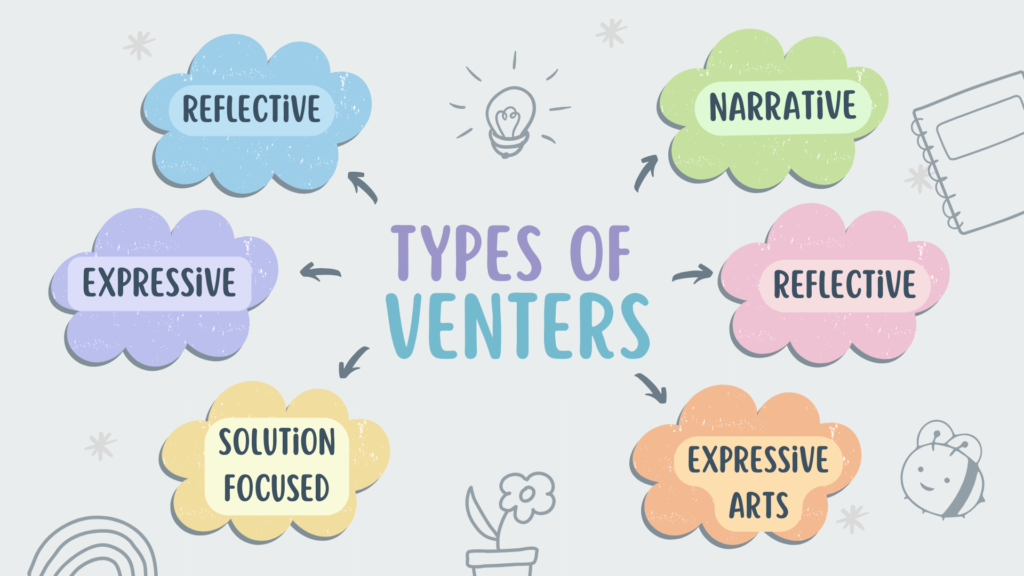
What is Venting
Venting, in simple words, means sharing or letting emotions out. It is a psychological and cathartic process to release pent-up feelings and alleviate emotional tension. Merriam-Webster Dictionary defines ‘Vent’ as a strong inner compulsion to express, especially in words. The other synonyms that it uses for the word EXPRESS, UTTER, VOICE, BROACH, and AIR.
Venting can take the form of spoken words, where individuals express their feelings verbally, or it can be a written process involving journaling or writing letters. It is different from emotional dumping, which can be more toxic involving blames and playing the victim, rather than seeking solutions.
How Venting helps as a Coping Strategy
Human emotions are complex and multifaceted, ranging from joy and contentment to anger and sorrow. In the hustle and bustle of daily life, individuals often find it challenging to fully express and process these emotions. Suppressing or ignoring emotions can lead to psychological distress, impacting mental health over time. Chronic emotional suppression may contribute to conditions such as anxiety disorders, depression, and even somatic symptoms.
Allowing oneself to express a range of emotions can be liberating. After releasing the pent-up emotions, one instantly feels better. It helps release stress. The process of articulating one’s feelings can lead to a better understanding of the underlying causes and triggers. This self-awareness is a crucial step in developing emotional intelligence and learning how to manage intense emotions effectively. That makes one better equipped to handle similar instances in the future.

Quotes from my clients:
“When you let me speak freely, I get more clarity, can hear my thoughts.”
“If I try doing it myself, I can’t focus on it for long. I would find distraction and avoid it. But in the session, even when no one is forcing, I feel safe in exploring myself deep.”
“My flow of thoughts is uninterrupted and it helps reach my solutions by myself.”
Venting with Family and Friends
We often share our emotional experiences with friends and family. Venting with friends and family involves expressing emotions, sharing experiences, and seeking support. Here are a few examples to illustrate how venting conversations might unfold:
Work Frustration with a Friend:
– You: “I had the most stressful day at work. My boss piled on so many tasks, and I feel like I can’t catch a break.”
– Friend: “That sounds really tough. What happened exactly?”
– You: “Well, first, there was this unexpected project, and then my coworker dropped the ball on our collaboration. I just needed to get it off my chest.”
Relationship Struggles with a Sibling:
– You: “I had a big fight with my partner today. We just can’t seem to agree on anything lately.”
– Sibling: “I’m sorry to hear that. What happened?”
– You: “We argued about money, and it escalated into a bigger issue. I feel so frustrated; I needed to talk to someone about it.”
Parenting Challenges with a Parent:
– You: “Being a parent is way harder than I thought. The kids are constantly fighting, and I feel like I’m failing.”
– Parent: “Parenting is tough; we all go through rough patches. What’s been going on?”
– You: “They won’t listen to anything I say, and I end up yelling. It’s exhausting, and I just need some advice or at least someone to listen.”
Friendship Woes with a Close Friend:
– You: “I’m feeling really hurt by something that happened with another friend. It’s been bothering me all day.”
– Close Friend: “I’m here for you. What’s going on?”
– You: “They didn’t invite me to an event, and I found out through social media. It might sound silly, but it hurt my feelings. I just needed to vent and get it out.”
These examples showcase the diversity of topics that people might vent about with friends and family. It allows us to offload stressors, gain perspective, and receive valuable input or advice, contributing to a more relaxed state of mind. Discussing challenges often leads to collaborative problem-solving.
Venting in Therapy:
Clients are overwhelmed with their distress experiences when they come to therapy. They may vent during the first session or do it in later sessions. Different clients have different needs and styles of venting.

Expressive Venters
: Share freely their emotions and thoughts without a specific structure. They seek a space to release pent up feelings and gain a sense of relief.Solution-Oriented Venters
: are more focused on problem-solving. They vent to seek practical advice, strategies, or coping mechanisms to address specific challenges.- Narrative Venters: vent by telling a detailed narrative of their experiences. They seek to make sense of their emotions and experiences through storytelling.
- Reserved Venters: may struggle with expressing themselves openly. They need a therapeutic space that allows them to vent at their own pace and feel safe while doing so.
- Reflective Venters: often seek to gain insights into their emotions and behaviors. They vent to understand the deeper meaning behind their experiences and explore personal growth.
- Routine Venters: find comfort in routine and structure. They may need a regular, predictable venting process as part of their therapy sessions.
- Expressive Arts Venters: with creative inclination, may find venting through expressive arts, such as drawing, writing, or music, to be particularly therapeutic.
What makes venting in professional setting different than letting out with friends and Family.
While family and friends offer a support system that help us navigate difficult situations throughout our lives, professional therapy settings create a safe space where venting can serve as a gateway to uncovering hidden traumas, unresolved conflicts and unmet needs. There are several criteria on which these two settings can be compared:

Confidentiality
One of the key differentiators in a professional therapy setting is the guarantee of confidentiality. Therapists are bound by ethical guidelines and legal obligations to maintain the privacy of their clients. This creates a secure environment where individuals can openly share their thoughts, feelings, and experiences without fear of or the risk of information being disclosed. On the other hand, there is no such binding with family/friends. There is always a risk of information passed on to someone else, and it is only mutual trust on the basis of which one shares.
Objectivity
Therapists bring a level of objectivity to the table that may be challenging for friends and family to provide. While loved ones may have personal biases or emotions tied to a situation, therapists offer a neutral perspective, allowing them to analyze issues without preconceived notions. This objectivity helps in fostering a deeper understanding of one’s thoughts and emotions.
Structured Sessions and Goal-Oriented Approach
While the informal conversations we have with friends and family may lack the structure, therapy sessions can be structured and goal-oriented needed for targeted personal development. Therapists may collaborate with clients to set achievable goals, creating a roadmap for progress.
Safe and Non-Judgmental Space
Professional therapy settings prioritize creating a safe and non-judgmental space. This environment encourages openness and vulnerability, fostering a deeper understanding of one’s inner world. While friends and family may unintentionally convey judgment or offer unsolicited advice, therapists are trained to remain non-judgmental and empathetic.
Specialized Training and Expertise
Professional therapists undergo extensive education and training to develop the skills necessary to guide individuals through various psychological challenges. Their knowledge extends beyond casual advice, delving into the realms of psychology, counseling theories, and therapeutic modalities. Unlike friends and family, therapists are not only listeners but also trained professionals who can provide valuable insights, coping mechanisms, and strategies for personal growth.
Ease of Reach
Friends or Family are easier to reach and approach. The moment you feel overwhelmed friends/family can be just a call away or you can see them easily. On the other hand, to visit a therapist one needs to schedule the session and may take some time. By the time you go for the session, it is possible that you may have temporarily resolved the issue, it doesn’t bother you as much as the intensity of the emotional experience is reduced.
Effect on Relationship
Venting can have both positive and negative effects on relationships with friends/ family. It can deepen our relationships with them as when we share our vulnerabilities, we create a space for intimacy and trust. The act of being there for one another in times of need builds a foundation of support, reinforcing the bonds that tie us together. On the other hand, when we persistently vent to someone, it can affect their emotional state adversely and put a strain on the relationship.
While in therapy, an ethical therapist would not let any personal feelings affect the professional relationship with the client.
Conclusion
In essence, the professional therapy settings offer a unique and invaluable space for individuals where simple venting or free expression becomes therapeutic. While friends and family contribute significantly to our support systems, therapy provides a distinct arena where confidentiality, objectivity, expertise, structured sessions, and a safe space converge to facilitate personal growth and healing. Recognizing the differences between everyday conversations and therapeutic interactions underscores the importance of both in nurturing a holistic approach to mental health.